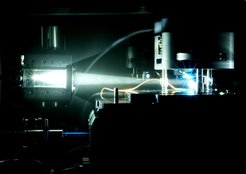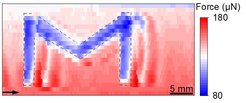Scanning Force Microscopy (SFM)

We investigate surfaces down to atomic resolution. Beside topography, specific operating modes are be used to characterize lateral frictional, elastic, thermal, and electrical material properties (Figure 1). In combination with infrared light (IR) illumination, we record local IR spectra with a lateral resolution <50 nm. The use of this nano-IR method allows us to locally detect the presence of chemical species in samples. The latter technique can be used for characterizing polymer blends, block-copolymers, coatings etc.
SFM is one of the core facility labs of the MPI-P. We teach students the use of SFM methods and we provide measurements for students on request.
Kelvin Probe Microscopy

in the photosensitive scanning probe microscope, two types of sample illumination are available: white light (top) and laser light at 488 nm (bottom).
As molecular electronics advances, the characterization of electrical properties becomes more and more important. In research and industry elements have already reached structure sizes down to a few nanometers. Therefore electrical modes of SFM play an increasing role for material characterization. Kelvin probe force microscopy (KPFM), for example, measures the electrical potential under the tip. Thereby, work function variations across the sample surface can be mapped with 10 nm lateral resolution. In particular for photovoltaic materials, light-induced changes in the measured contact potentials are associated to charge transport. In order to study light induced charging of surfaces, we have built up a photo-sensitive SFM which is situated in a glove box (Figure 2). The glove box is filled with pure Ar gas. We use this SFM to investigate all-solid-state battery materials while charging and discharging.
References
Yalcinkaya, M.Y.; Hermes, I.M.; Seewald, T.; Amann-Winkel, K.; Veith, L.; Schmidt-Mende, L.; Weber, S.A.L. Chemical Strain Engineering in MAPbI3 Perovskite just accepted in Advanced Energy Materials (2022)
Chao Zhu, Till Fuchs, Stefan A.L. Weber, Felix. H. Richter, Gunnar Glasser, Franjo Weber, Hans-Jürgen Butt, Jürgen Janek, Rüdiger Berger, Nature Communications 14, 1300 (2023). https://doi.org/10.1038/s41467-023-36792-7
Drop Friction Forces

In rain, drops form on windows. If the drops are large enough, they will run down the window. In order to measure drop sliding forces, we have built a drop friction force instrument (DoFFI). In DoFFI a sessile drop sticks to a force sensor by capillary action. When the sample moves laterally, the force sensor deflects until the drops starts sliding over the surface. DoFFI is a 2D characterization tool, which allows imaging of local variations in surface wetting properties by plotting the measured friction force at each drop position. We were able to resolve the wetting features from centimeter to submillimeter sizes (Figure 3). Even surface features having sizes much smaller than the drop diameter are visible and can be characterized. The sDoFFI is not limited to laboratory-based samples but is also suited for characterization of biological and technological surfaces.
References
Chirag Hinduja, Alexandre Laroche, Sajjad Shumaly, Yujiao Wang, Doris Vollmer, Hans-Jürgen Butt, and Rüdiger Berger, Scanning Drop Friction Force Microscopy, Langmuir 38, 14635-14643 (2022).DOI: https://doi.org/10.1021/acs.langmuir.2c02046


